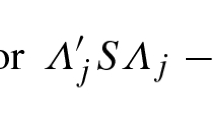Abstract
Current practice in factor analysis typically involves analysis of correlation rather than covariance matrices. We study whether the standardz-statistic that evaluates whether a factor loading is statistically necessary is correctly applied in such situations and more generally when the variables being analyzed are arbitrarily rescaled. Effects of rescaling on estimated standard errors of factor loading estimates, and the consequent effect onz-statistics, are studied in three variants of the classical exploratory factor model under canonical, raw varimax, and normal varimax solutions. For models with analytical solutions we find that some of the standard errors as well as their estimates are scale equivariant, while others are invariant. For a model in which an analytical solution does not exist, we use an example to illustrate that neither the factor loading estimates nor the standard error estimates possess scale equivariance or invariance, implying that different conclusions could be obtained with different scalings. Together with the prior findings on parameter estimates, these results provide new guidance for a key statistical aspect of factor analysis.
Similar content being viewed by others
References
Aitchison, J., & Silvey, S. D. (1958). Maximum likelihood estimation of parameters subject to restraints.Annals of Mathematical Statistics, 29, 813–828.
Archer, C. O., & Jennrich, R. I. (1973). Standard errors for orthogonally rotated factor loadings.Psychometrika, 38, 581–592.
Bentler, P. M. (1976). Multistructure statistical model applied to factor analysis.Multivariate Behavioral Research, 11, 3–25.
Browne, M. W. (1982). Covariance structures. In D. M. Hawkins (Ed.),Topics in applied multivariate analysis (pp. 72–141). Cambridge: Cambridge University Press.
Browne, M. W., & Arminger, G. (1995). Specification and estimation of mean and covariance structure models. In G. Arminger, C. C. Clogg, & M. E. Sobel (Eds.),Handbook of statistical modeling for the social and behavioral sciences (pp. 185–249). New York: Plenum.
Cudeck, R. (1989). Analysis of correlation matrices using covariance structure models.Psychological Bulletin, 105, 317–327.
Cudeck, R., & O'Dell, L. L. (1994). Applications of standard error estimates in unrestricted factor analysis: Significance tests for factor loadings and correlations.Psychological Bulletin, 115, 475–487.
Jennrich, R. I. (1973). Standard errors for obliquely rotated factor loadings.Psychometrika, 38, 593–604.
Jennrich, R. I. (1974). Simplified formulae for standard errors in maximum-likelihood factor analysis.British Journal of Mathematical and Statistical Psychology, 27, 122–131.
Jennrich, R. I., & Thayer, D. T. (1973). A note on Lawley's formulas for standard errors in maximum likelihood factor analysis.Psychometrika, 38, 571–580.
Kaiser, H. F. (1958). The varimax criterion for analytic rotation in factor analysis.Psychometrika, 23, 187–200.
Krane, W. R., & McDonald, R. P. (1978). Scale invariance and the factor analysis of correlation matrices.British Journal of Mathematical and Statistical Psychology, 31, 218–228.
Lawley, D. N., & Maxwell, A. E. (1971).Factor analysis as a statistical method (2nd ed.). New York: American Elsevier.
Lee, S. Y., & Bentler, P. M. (1980). Some asymptotic properties of constrained generalized least squares estimation in covariance structures.South African Statistical Journal, 14, 121–136.
Lehmann, E. L., & Casella, G. (1998).Theory of point estimation. New York: Springer-Verlag.
Magnus, J. R., & Neudecker, H. (1988).Matrix differential calculus with applications in statistics and econometrics. New York: Wiley.
Maxwell, A. E. (1959). Statistical methods in factor analysis.Psychological Bulletin, 56, 228–235.
McDonald, R. P., Parker, P. M., & Ishizuka, T. (1993). A scale-invariant treatment for recursive path models.Psychometrika, 58, 431–443.
Norusis, M. J. (1996).SPSS professional statistics. Chicago: SPSS.
Ogasawara, H. (1996). Standard errors for rotated factor loadings by normalized orthomax method.Japanese Journal of Behaviormetrics, 23, 122–129.
Ogasawara, H. (1998a). Standard errors of several indices for unrotated and rotated factors.Economic Review, 49, 21–69 (Otaru University of Commerce)
Ogasawara, H. (1998b). Standard errors for rotation matrices with an application to promax solution.British Journal of Mathematical and Statistical Psychology, 51, 163–178.
Swaminathan, H., & Algina, J. (1978). Scale freeness in factor analysis.Psychometrika, 43, 581–583.
Author information
Authors and Affiliations
Additional information
We gratefully acknowledge the help of the Associate Editor and three referees whose constructive comments lead to an improved version of the paper. This work was supported by National Institute on Drug Abuse Grants DA01070 and DA00017 and by the University of North Texas Faculty Research Grant Program.
Rights and permissions
About this article
Cite this article
Yuan, KH., Bentler, P.M. On equivariance and invariance of standard errors in three exploratory factor models. Psychometrika 65, 121–133 (2000). https://doi.org/10.1007/BF02294189
Received:
Revised:
Issue Date:
DOI: https://doi.org/10.1007/BF02294189




